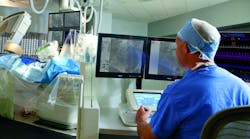Being a vascular surgeon in a catheter lab is strenuous work. After a person has a heart attack, they may undergo non-invasive surgery called percutaneous coronary intervention (PCI), where a surgeon inserts a catheter containing a stent through a small incision and guides it through an artery or vein until it reaches the part with plaque buildup. Then the stent is expanded via a balloon or other mechanism to widen the vessel for better blood flow, and the surgeon pulls the catheter out. PCI is guided through X-ray imaging so that the surgeon can see what he or she is doing inside the body.
But chronic exposure to X-ray radiation has been linked to cancer, premature aging, and other health problems in catheter surgeons. X-rays are ionizing, meaning that they effect the surgeon's body at an atomic level, and after 20+ years of exposure, this can cause irreversible cellular damage. To combat this, surgeons wear lead bibs to prevent ionizing radiation from penetrating their cells. But wearing this heavy radiation armor can cause other problems like chronic back pain and spinal injury, especially when surgeons lean over their patient for hours during meticulous surgery.
Hospitals across the country are employing CorPath PCI robots from Corindus to improve the health of their surgeons and perform steady-handed surgery on their patients. The video below includes a case study from Dr. Vijay Iyer at Gates Vascular Institute in Buffalo, NY.
Released in January, CorPath is the first robot to be cleared for PCI by the FDA. The CorPath bedside units are controlled by surgeons in a room protected from radiation, called the Intervention Cockpit. The surgeon uses joystick and touch-screen controls to guide the catheter to the damaged artery or vein. Surgeons can leave the robots in a stand-still state so that they will not move and cause damage if the surgeon needs to briefly leave the cockpit.
First, the CorPath system can use X-ray imaging to measure the clot for the correct balloon stent to be inserted. When positioning the stent at the clot, the catheter can be moved in the vessel with a resolution of 1 mm. The bedside unit includes a motor on the robot arm's wrist for precise positioning and another drive to adjust the height. A one-use cassette contains the drives that feed the catheter into the patient at the proper angles. They have an open-architecture design so that surgeons can interchange a wide variety of tools and guidewires with diameters as large as 0.36 mm (0.014 in.) The function of the cassette can be seen in the video below:

